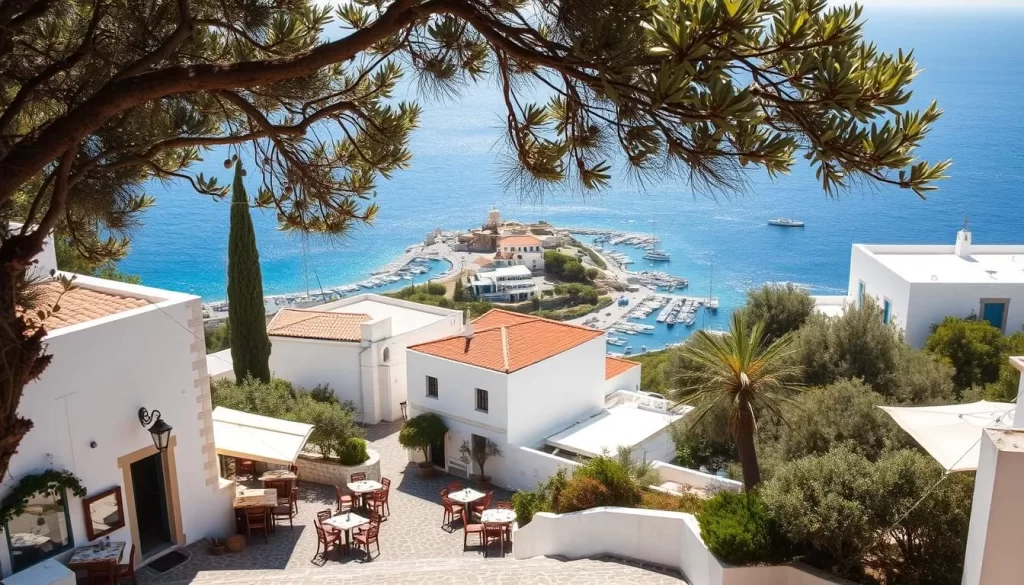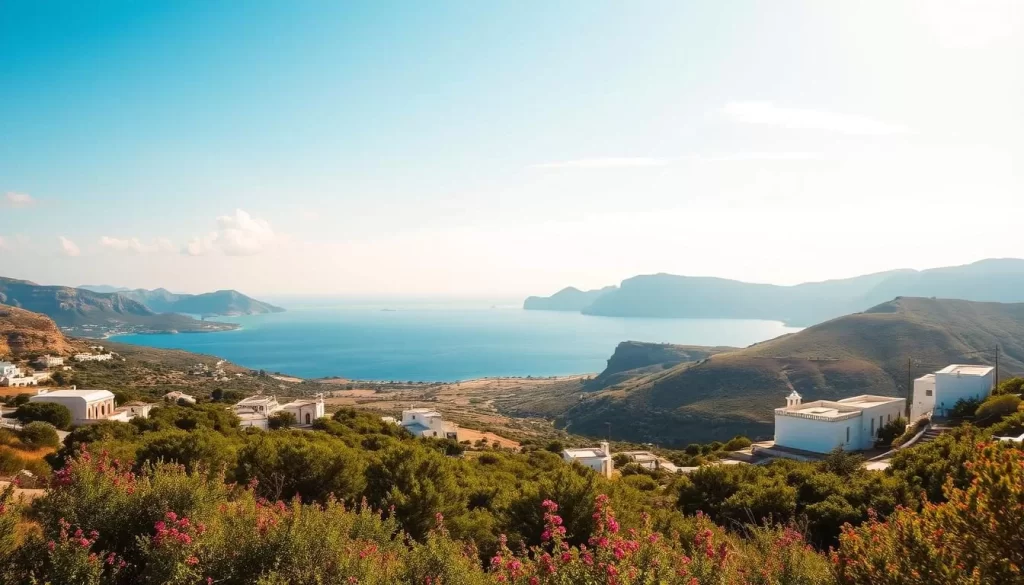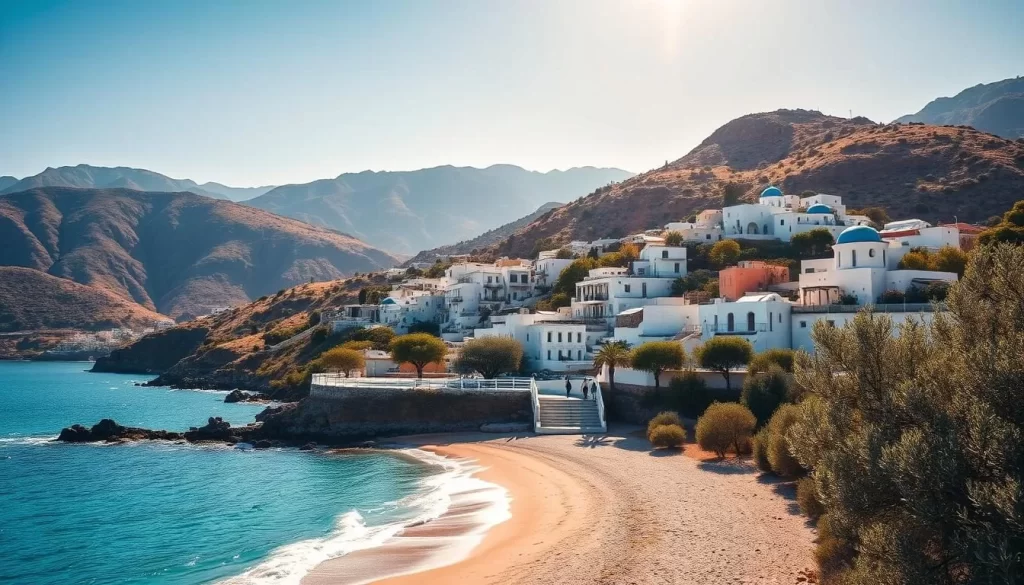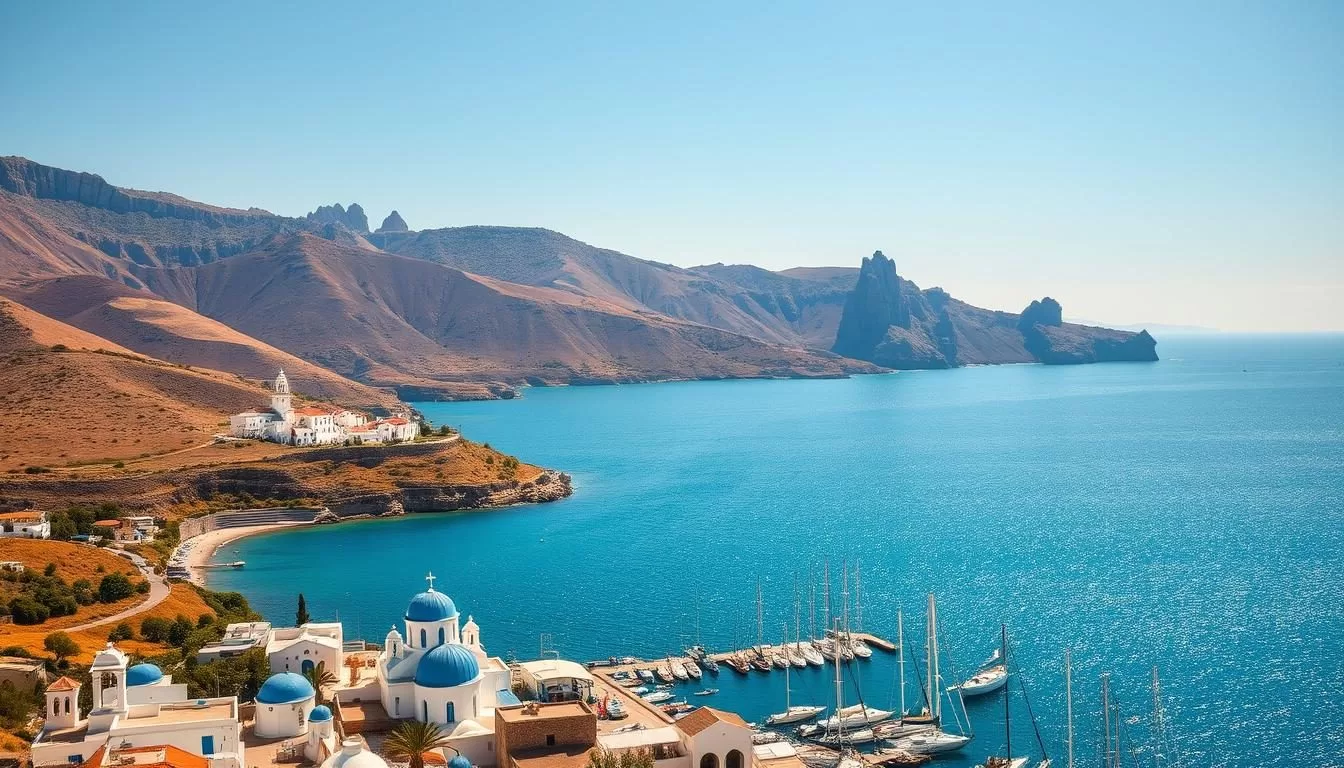✓ Accommodations✓ Flights✓ Rental Cars✓ Tours & Activities ✓ Tours & Activities
Planning your getaway to the Mediterranean’s most picturesque destinations? Timing is everything. Choosing the best time visit can make your trip unforgettable. You’ll enjoy perfect weather, fewer crowds, and even save money.
Spring and autumn are ideal for a balanced experience. From April to June and September to October, temperatures are warm but not scorching. These months also offer fewer crowds and lower prices compared to the busy summer season.
Summer, especially July and August, brings peak tourist activity. While the weather is hot, it’s also the most crowded time. If you prefer a quieter vibe, consider the shoulder season. It’s the best time to explore without the hustle and bustle.
Ready to dive into the details? This guide will help you pick the perfect time visit for your adventure. Let’s make your trip as smooth as the Mediterranean breeze.
Introduction to the Cyclades Experience
Timing your visit can transform your travel experience from good to unforgettable. The Mediterranean climate plays a huge role in shaping your trip. Warm summers and milder winters create a perfect backdrop for exploring the islands.
Early summer or the shoulder seasons are ideal for a balanced experience. You’ll enjoy pleasant temperatures and fewer crowds compared to the peak months of July and August. This is the best time for outdoor activities like hiking or beach relaxation.
Local festivals and events add a cultural depth to your stay. From traditional celebrations to music festivals, these experiences make your trip even more memorable. Avoiding peak tourist times also means you can explore at your own pace without the hustle and bustle.
Planning your trip based on weather and seasonal trends has its perks. You’ll save on prices, enjoy comfortable temperatures, and have more opportunities for sightseeing. Whether you’re visiting in spring, autumn, or winter, each season offers its own unique charm.
Understanding Greece’s Mediterranean Climate
Greece’s climate is as diverse as its landscapes, offering something for every traveler. The Mediterranean climate here is characterized by mild, wet winters and hot, dry summers. This pattern makes it a great time to visit throughout the year, depending on your preferences.

In the northern mainland, winters can be cooler, with temperatures dropping to -3°C. Meanwhile, the southern regions stay warmer, averaging around 7°C during the colder months. This contrast allows you to choose the best spot for your trip based on the weather.
Overview of Seasonal Weather Patterns
Spring and autumn are ideal for those looking to avoid crowds. Temperatures range from 15°C to 25°C, making it perfect for outdoor activities like hiking or sightseeing. These shoulder seasons also offer lower prices on flights and accommodations.
Summer, especially July and August, brings peak tourist activity. Temperatures often exceed 30°C, and in some areas, they can reach up to 40°C. While the weather is ideal for beach days, it’s also the busiest time year for tourists.
Regional Temperature and Rainfall Variations
Rainfall varies significantly across the country. The Ionian Islands receive more rain compared to the southern coast of Crete, which gets less than 14 inches annually. This makes the southern regions a better choice for those seeking sunny skies.
| Region | Summer Highs | Winter Lows | Annual Rainfall |
|---|---|---|---|
| Northern Mainland | 30°C | -3°C | 20-30 inches |
| Southern Islands | 40°C | 7°C | 10-14 inches |
“The Mediterranean climate offers a perfect balance of warm summers and mild winters, making it a year-round destination.”
Understanding these patterns can help you pick the best month for your visit. Whether you’re exploring a bustling city or relaxing on a quiet beach, the weather plays a key role in shaping your experience.
Cyclades Islands, Greece: Best Months for a Weather-Savvy Trip – Month-by-Month Insights
Discover the perfect timing for your Mediterranean adventure with this detailed guide. Each month offers unique experiences, from blooming wildflowers in spring to warm waters in autumn. Understanding these seasonal dynamics helps you tailor your trip to your preferences.

Spring and Early Summer Advantages
Spring is a magical time to visit. From March to May, temperatures range from 15°C to 25°C, making it ideal for outdoor activities like hiking and exploring ancient ruins. The blooming wildflowers add a vibrant touch to the landscape.
Early summer, from June to July, strikes a balance between warm weather and manageable tourist traffic. The beaches are inviting, and the water is pleasantly warm, perfect for swimming and relaxation.
Autumn and Winter Perspectives
Autumn, from September to November, offers pleasant temperatures and fewer crowds. This is also the time for local festivals, adding a cultural depth to your trip. The weather remains mild, making it great for sightseeing.
Winter, from December to February, is quieter and more budget-friendly. While the weather is cooler, it’s still a great time to explore without the hustle and bustle. You’ll find lower prices on accommodations and flights.
| Month | Temperature | Crowd Level | Activities |
|---|---|---|---|
| March-May | 15°C – 25°C | Low | Hiking, Sightseeing |
| June-July | 25°C – 30°C | Moderate | Beach, Swimming |
| September-November | 20°C – 28°C | Low | Festivals, Sightseeing |
| December-February | 10°C – 15°C | Very Low | Budget Travel, Exploration |
“Timing your visit to match your preferences ensures a memorable and enjoyable trip.”
Whether you’re seeking vibrant festivals or serene landscapes, each season offers something special. Plan your trip wisely to make the most of your Mediterranean adventure.
Exploring Top Destinations and Activities in Greece
Greece is a treasure trove of destinations, blending iconic landmarks with hidden gems waiting to be discovered. Whether you’re drawn to bustling cities or serene islands, there’s something for every traveler. Planning your trip around the best month can help you avoid crowds and enjoy lower prices on flights and accommodations.

Island Highlights and Hidden Gems
While Santorini and Mykonos are must-visit spots, consider exploring lesser-known islands like Milos. Known for its lunar-like beaches and traditional boathouses, Milos offers a unique experience away from the summer crowds. The island’s western flank is perfect for off-road guided tours, offering breathtaking views and secluded spots.
Crete, the largest Greek island, is another fantastic destination. Its rich heritage, from ancient ruins to vibrant festivals, makes it a cultural hub. Don’t miss the olive harvest events, which provide a glimpse into local traditions.
Seasonal Attractions and Cultural Events
Greece’s calendar is packed with festivals and celebrations that vary by season. In Athens, the Acropolis stands as a UNESCO World Heritage Site, offering a glimpse into ancient history. Admission is around 20 euros, making it an affordable attraction.
For a deeper dive into history, visit the National Archaeological Museum. It houses the Antikythera mechanism, a 2,000-year-old artifact that showcases ancient ingenuity.
Seasonal events like the Armata Festival in Spetses and the olive harvest in Crete add a cultural layer to your trip. These celebrations are best enjoyed during the shoulder seasons, when you can avoid crowds and immerse yourself in local traditions.
| Season | Attraction | Location |
|---|---|---|
| Spring | Armata Festival | Spetses |
| Summer | Beach Exploration | Milos |
| Autumn | Olive Harvest | Crete |
| Winter | Acropolis Museum | Athens |
“Exploring both iconic landmarks and hidden gems ensures a richer and more authentic travel experience.”
Whether you’re hiking Mount Olympus or strolling through Thessaloniki’s lively foodie scene, Greece offers endless opportunities for outdoor activity and sightseeing. Plan your trip wisely to make the most of your adventure.
Travel Tips for Your Weather-Savvy Greek Getaway
Make your Mediterranean adventure seamless with these practical travel tips. Whether you’re planning a trip during the warm summer or the cooler winter months, these insights will help you pack smart and save money.

Packing Essentials and What to Wear
Packing for your destination depends on the season. In summer, lightweight fabrics like cotton and linen are ideal for staying cool. Don’t forget sunscreen and a wide-brimmed hat for beach days.
For spring and autumn, layering is key. Bring a lightweight sweater or cardigan for cooler evenings. Comfortable walking shoes are a must for exploring historical sites.
In winter, pack warm, waterproof jackets and water-resistant shoes. This ensures you stay comfortable while exploring cities or coastal areas.
Strategies to Avoid Crowds and Score Deals
To avoid crowds, consider traveling during the shoulder seasons of spring and autumn. You’ll enjoy pleasant temperatures and fewer tourists.
Book your flights and accommodations at least 3-4 months in advance for peak season travel. This ensures better availability and prices.
For off-peak travel, look for deals on hotels and ferries. Many providers offer discounts during quieter months.
| Season | Packing Essentials | Booking Tips |
|---|---|---|
| Summer | Lightweight clothing, sunscreen, hat | Book 3-4 months in advance |
| Spring/Autumn | Layered clothing, walking shoes | Look for shoulder-season discounts |
| Winter | Warm jacket, waterproof shoes | Search for off-peak deals |
“Smart packing and strategic booking can transform your trip into a stress-free adventure.”
For more detailed insights on planning your visit, check out this comprehensive guide.
Optimal Time for Outdoor Adventures and Local Celebrations
Exploring the Mediterranean’s outdoor wonders and cultural festivities can elevate your travel experience. Each season offers unique opportunities to connect with nature and local traditions. Whether you’re hiking scenic trails or joining vibrant celebrations, timing your visit ensures you make the most of your trip.
Hiking Trails and Natural Beauty
Spring is the perfect time to explore blooming trails and enjoy mild temperatures. The Samaria Gorge hike, spanning 16 kilometers, offers breathtaking views and takes 5-7 hours to complete. For a quieter experience, visit during the shoulder seasons of fall or early winter.
In summer, coastal hikes and sailing adventures are ideal. However, be prepared for the summer crowds. Early mornings or late afternoons are the best time to avoid crowds and enjoy the scenery.
Festivals and Traditional Events
Local celebrations add a cultural depth to your visit. The Armata Festival in Spetses, held in September, showcases traditional boat races and fireworks. Another highlight is the olive harvest in Crete, where you can join feasts and learn about local traditions.
For a unique experience, visit during the Patras Carnival, which runs from January to the start of Lent. This lively event features parades, costumes, and music. Timing your visit around these festivals ensures you immerse yourself in authentic Greek culture.
Tips for Planning Your Adventure
To avoid crowds, consider traveling during the shoulder seasons of spring or autumn. You’ll enjoy pleasant weather and lower prices on accommodation and flights.
“Timing your visit to align with outdoor adventures and local celebrations ensures a richer and more memorable experience.”
Navigating Transportation and Accommodations
Getting around the Mediterranean efficiently can make or break your travel experience. Whether you’re hopping between islands or exploring mainland cities, planning your transportation and accommodation in advance ensures a smooth and cost-effective trip.
Booking Ferries and Flights
Ferries are a popular way to travel between islands, with routes typically taking 2 to 4 hours and costing between $30 to $70. Booking one-way tickets in advance can save you money and provide flexibility. For longer distances, consider flights, which can be more affordable if booked early. Budget carriers like Ryanair and easyJet offer great deals.
If you’re traveling between Santorini and Mykonos, ferries take 2 to 3 hours, while flights are quicker but often more expensive. For more details on this route, check out this .
Finding Affordable Stays
Accommodation costs vary by season. During peak summer months, hotel rates in popular destinations like Santorini can exceed $300 per night. However, traveling during the shoulder seasons of late April-May or September-October can lead to better prices and fewer crowds.
Consider staying on lesser-known islands like Paros or Naxos, where you can find stays for $150 or less per night. For a detailed itinerary on exploring Sifnos, visit this resource.
| Transportation | Cost | Booking Tips |
|---|---|---|
| Ferries | $30-$70 | Book one-way tickets in advance |
| Flights | Varies | Use budget carriers for deals |
| Accommodation | Cost | Seasonal Tips |
| Hotels (Peak) | $300+ | Book 3-4 months in advance |
| Hotels (Shoulder) | $150 or less | Travel in late spring or early fall |
“Smart planning and early bookings can save you money and make your trip more enjoyable.”
By balancing convenience with cost, you can make the most of your Mediterranean adventure. Whether you’re exploring bustling cities or serene islands, these tips will help you navigate your travel logistics with ease.
Conclusion
Your next adventure awaits with the perfect blend of weather, culture, and relaxation. Timing your trip can make all the difference, ensuring you enjoy pleasant temperatures and fewer crowds. Whether you visit in spring, summer, or autumn, each season offers unique experiences.
Plan wisely to take advantage of lower prices and great times. Use this guide to choose the best month for your destination. From beach days to cultural events, every activity is better with the right timing.
For more inspiration, explore the breathtaking beauty of Santorini or consider a 3-day cruise to discover hidden gems. Start planning today for an unforgettable trip!
The above is subject to change.
Check back often to TRAVEL.COM for the latest travel tips and deals.






